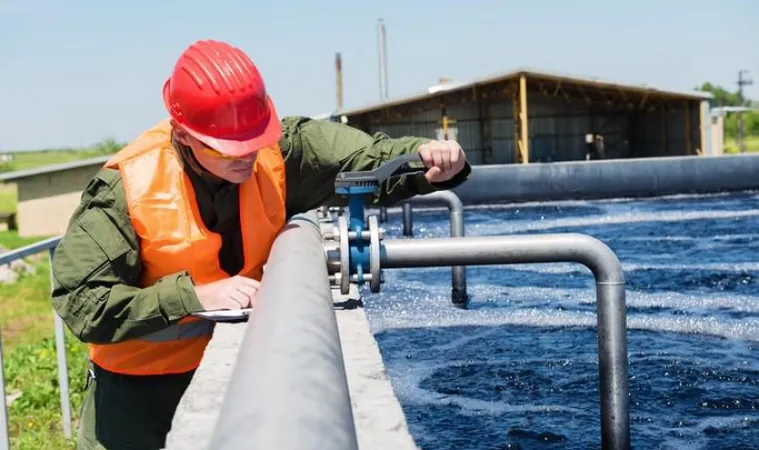
Unlocking Flu Preparedness: How Wastewater Monitoring is Gaining Traction in the U.S.
2024-09-20
Author: Nur
Recent findings published in the Morbidity and Mortality Weekly Report (MMWR) underscore the potential of wastewater surveillance in enhancing public health strategies against influenza viruses, including the H5N1 avian flu. The study revealed that a staggering 95% of American adults are willing to undertake protective measures if wastewater data indicates disease transmission in their community.
Wastewater Surveillance: An Essential Tool
Conducted by researchers from the Centers for Disease Control and Prevention (CDC) alongside various public health agencies, the study monitored levels of the influenza A virus and the H5 subtype in wastewater from January to August 2024. This coincided with an ongoing H5N1 outbreak affecting U.S. cattle and poultry, alongside 13 reported human infections.
The study notes that while wastewater surveillance is crucial for tracking influenza viruses, current methodologies lack the ability to differentiate between human and animal virus sources. The authors recommend that public health agencies enhance their monitoring systems to include testing for specific influenza A subtypes, positioned as a proactive response to existing and future outbreaks.
Through monitoring efforts across 309 sites in 38 states from May 12 to July 13, 2024, researchers detected concerning concentrations of the virus at 11 sites across California, Illinois, Kansas, and Oregon—areas already exhibiting signs of human flu activity.
What the Data Reveals
From H5 subtype testing at 203 sites in 41 states, 24 sites in nine states revealed the presence of H5 in wastewater. Significantly, seven of those states reported H5N1-infected animal herds. Meanwhile, Colorado and Michigan documented human infections linked to the H5N1 strain.
Interestingly, contamination sources ranged from agricultural facilities, such as milk and meat processing plants, to wild birds and domestic poultry farms, emphasizing that wastewater data can shine a light on zoonotic outbreaks when properly analyzed.
Public Support is Strong
A survey conducted between July 24 and July 26, 2024, by Porter Novelli Public Services, established a solid foundation of public support for wastewater monitoring among U.S. adults. Out of 1,016 participants, about 74.6% expressed support for initiatives aimed at monitoring infectious diseases via wastewater. This consensus crossed various demographics but showed variations related to age, education, and marital status.
Respondents demonstrated a significant desire for rapid access to wastewater data—even if such data was insufficient to precisely inform public health risks or actions. Black respondents were most in favor of accessing this vital information, followed closely by Hispanic respondents and others, with significant support also noted among urban dwellers and employed individuals.
Alarmingly, 95.3% of the participants indicated they would consider taking protective actions, such as increased handwashing, avoiding crowded places, and steering clear of high-risk individuals should they become aware of a flu virus presence in their area.
A Call for Action
As the study highlights, effective coordination across various sectors—including public health, agriculture, and environmental services—is essential for maximizing the benefits of wastewater monitoring. The need for clarity in public health communications regarding wastewater data interpretations is more crucial than ever to ensure awareness and readiness in the face of potential influenza outbreaks.
The importance of these findings cannot be overstated; as we look toward the future, a united approach leveraging wastewater surveillance could revolutionize our public health response, helping to safeguard communities against emerging threats like the H5N1 virus. Stay informed, stay safe, and join the movement toward enhanced health protections in your area!



 Brasil (PT)
Brasil (PT)
 Canada (EN)
Canada (EN)
 Chile (ES)
Chile (ES)
 Česko (CS)
Česko (CS)
 대한민국 (KO)
대한민국 (KO)
 España (ES)
España (ES)
 France (FR)
France (FR)
 Hong Kong (EN)
Hong Kong (EN)
 Italia (IT)
Italia (IT)
 日本 (JA)
日本 (JA)
 Magyarország (HU)
Magyarország (HU)
 Norge (NO)
Norge (NO)
 Polska (PL)
Polska (PL)
 Schweiz (DE)
Schweiz (DE)
 Singapore (EN)
Singapore (EN)
 Sverige (SV)
Sverige (SV)
 Suomi (FI)
Suomi (FI)
 Türkiye (TR)
Türkiye (TR)
 الإمارات العربية المتحدة (AR)
الإمارات العربية المتحدة (AR)